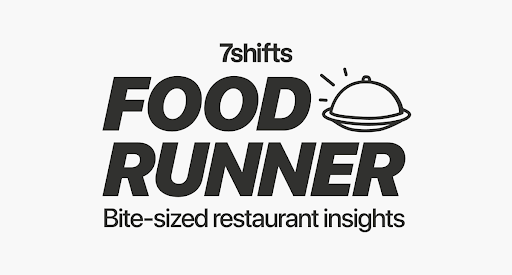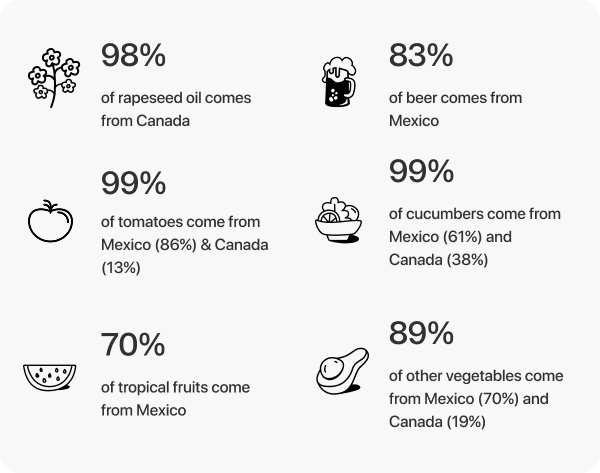|
|
|
Tulips, time travel, and why your restaurant’s labor costs might be creeping up—three things that have absolutely nothing in common. But hey, that’s the vibe this month. In this edition, we don’t have a theme. Just a smattering of helpful insights. Think of it like a chef’s special: unexpected, but exactly what you need.
|
|
|
|
 |
Tariffs and your restaurant |
 |
Training is… fun? |
 |
Everyone’s least favorite season is here (taxes) |
|
|
|
|
Caught in 4K: real-life footage of the Food Runner team trying to write this issue as news changes by the hour.
|
|
 |
IN THE (TARIFF) NEWS
|
|
1/3 of independent U.S. restaurants expect a sales decline
All eyes are on this “will they won’t they” trade war––and that includes restaurant owners. A recent survey found that one-third of independent U.S. restaurants anticipate a drop in sales if substantial tariffs are imposed on goods from Canada, Mexico, and China.
Chipotle may be safe: Only 50% of avocados come from Mexico
Chipotle Mexican Grill doesn’t expect major cost disruptions from tariffs on imports. The fast-casual chain estimates its cost of sales would rise by only 0.6 percentage points if tariffs on Canada, Mexico, and China take effect. While Mexico supplies 90% of the U.S.’s avocados, Chipotle sources about half of its avocados elsewhere. In recent years, the restaurant chain has made efforts to diversify its avocado suppliers––talk about staying ahead of the game.
Not just cars and construction, but Coca-Cola too
25% taxes on top of 25%––that’s the (seemingly constantly in-flux) plan for steel and aluminum imports. And it’s not just the automotive and construction industries feeling the heat. The cost of a can for your customer’s favorite soda could rise too. Back in 2018, Coca-Cola hiked prices after a 10% tariff drove up production costs. And now, with even steeper tariffs coming, the brand has plans to sell more soda in plastic bottles.
🎙 Related listening: Hot off the Pre-Shift podcast airwaves, a new episode with Jay Ashton focused on tariffs specifically. Which products will be most impacted by tariffs? Should restaurants raise their menu prices? What can restaurants do to diversify their revenue streams? We take 38 minutes to dive in to the impact.
|
|
 |
BY THE NUMBERS
|
|
What percentage of goods does the U.S. actually import from Canada and Mexico? The New York Times reported on numbers from 2023.
|
|
|
 |
DEBATABLE
|
|
Q: The Canadian government instituted a tax break on dining to boost the economy. Was it worth it?
|
Canada’s two-month tax break on certain items, including food and beverages, ended in mid-February. Restaurants Canada called for the tax holiday to be made permanent, with early stats showing promising results.
The anticipated sales boost? A staggering $1.5 billion over the 60 days. OpenTable also reports an 18% jump in seated diners year-over-year during the first 2 weeks. And in Ontario alone, it was 23%. But the success of the holiday may very well depend on who you ask.
In contrast, payment processor Moneris reported a 6% decrease in transaction volume at Canadian restaurants during month one of the tax holiday. And some diners took to Reddit to report restaurants that either didn’t comply or hiked prices to capitalize on the temporary savings. In the early days, restaurant owners also pointed out how difficult it was to adjust pricing systems on such short notice.
|
|
 |
STORIES FROM THE FLOOR
|
|
|
|
What if mandatory training didn’t have to be boring?
ArrowUp is an online training platform that offers courses designed specifically for restaurants. Putting an end to boring, monotonous content, Founder Jason Berkowitz is all about presenting training information in an engaging, relatable manner—with the help of an occasional meme or gif.
In the first Pre-Shift Podcast episode for 2025, we sat down with Jason to discuss—you guessed it—training!
|
📌 On the importance of proper training
Consistency is key: “Put in a consistent training program. Have consistent follow-ups with a few checklists, check-ins, five questions a week for somebody—things like that. You lower turnover by an astonishing amount. You lower risk, you lower liability, and you increase sales.”
The biggest training mistake: “ I think lack of attention is the biggest mistake. How do I feel like you’re paying attention to me? How do I feel like I’m part of something, not just a number? So first off, are we paying attention to you and actually delivering something? Secondly, are we finding out that you’re learning the way that it works for you to learn?”
📌 On making a good first impression with new employees
Give enough attention: “The most important thing out of the gates when I walk in the door as a new employee, does somebody expect me to be there? And does somebody care that I’m there? And does somebody spend time with me now that I’m there? … [or] is it feeling like the playground?”
Sprinkle in some fun: “I don’t like day one HR everything. I really don’t. Sure, anti-harassment training, but you could drip that in. Get the fun in. Get them moving around, introduce them to people. Bring them into the fold so they feel comfortable and excited walking into work the next day.”
📌 On growing restaurant careers from within
The importance of supervisors: “I love putting people on the growth trajectory. The worst thing you can do is not have people in the pipeline, so when you lose a supervisor, you need a supervisor. Supervisors are the bridge between the expectation and what gets executed. They know where the bodies are buried. They know where the good is, and where the bad is.”
Empower accountability: “Supervisors need more than the ability to comp food and a pair of keys to be successful. You’ve got to start with soft skills and train them up. Help them have awkward conversations and empower them to know that actually holding everybody accountable is the coolest thing you can do. Because organized people want to work in organized environments. Accountable people want to work in environments where everyone’s held accountable.”
For more training insights from Jason, listen to the full episode or read the recap.
|
|
 |
BECAUSE YOU COULD USE A LAUGH
|
|
With tariffs and taxes looming, here’s a little comic relief.
|
|
|
 |
FRIENDLY REMINDER
|
|
Everyone’s least favorite season is here … and no, we don’t mean spring. Here are some key upcoming Canadian tax filing dates to remember:
March 31
💰 Partnership information return deadline
April 30
✍ Personal income tax return deadline
June 16 (the 15th falls on a weekend)
💰 Self-employed income tax return deadline
June 30
💰 Self-employed income tax return deadline
Heads up! Sole proprietorships and partnerships have different filing dates than corporations, so make sure you’re aware of all applicable deadlines for your business. Read this guide for more information.
Note: We’ve tried to ensure accurate information here, but we aren’t accountants and this isn’t intended as advice. We accept no liability for errors or omissions. Always consult an advisor if you have questions about your situation.
|
|
 |
QUIET ON SET
|
|
How to write a great restaurant business plan in under 12 minutes?
Well, it’ll take you a bit more time than that, but Sam Fung breaks down the how-to in 11 minutes and 40 seconds.
One of the most essential steps in securing funding and launching a successful restaurant is creating a solid business plan. Whether you’re an aspiring restaurant owner––or an existing owner looking for a clearer roadmap––she covers every key section you’ll need:
| 👉 Company description |
| 👉 Market analysis |
| 👉 Marketing strategy |
| 👉 Operations overview |
| 👉 Financial projections |
|
|
|
|
 |
À LA CARTE
|
|
You don’t have time for pointless articles. These aren’t those.
✨ The average dine-in spend of a Gen Z customer is $51. That’s more than Millennials ($50), Gen X ($49), and Boomers ($45). As the generation continues to grow older––and increase their spending power––it’s time to adapt. And no, that doesn’t include greeting your customers as ‘besties’.
📖 Read: How to Adapt Your Restaurant for Gen Z
👨 The average chef in the U.S. makes about $55,000 each year. Servers on the other hand? A bit more than $31,000. But like all other jobs, salary depends. We compared wages for all different restaurant positions (and by location), so you can determine whether you’re paying right.
📖 Read: How Much Do Chefs Make?
📖 Read: How Much Do Servers Make?
|
|
|
|















